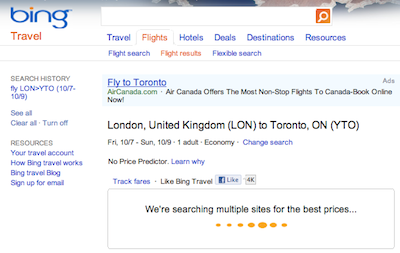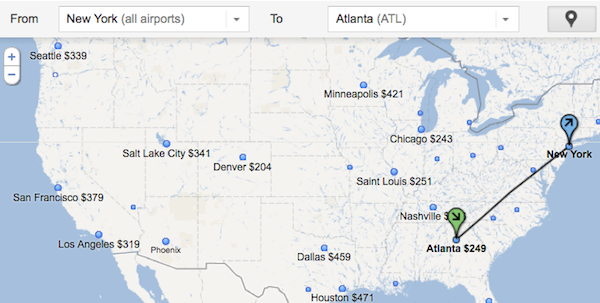Google Flight Search Takes Off
If Google's approach to email was conversation threading, then Google's approach to flight search is... not having to drum your fingers watching an irritating interstitial page... whilst the flight data is loading.
If Google's approach to email was conversation threading, then Google's approach to flight search is... not having to drum your fingers watching an irritating interstitial page... whilst the flight data is loading.

The search industry has been watching and waiting to see what Google will do in the flight search vertical since Google’s acquisition of ITA, which was given the ‘all-clear’ by the Department of Justice five months ago. Google has now launched Google.com/flights and is in the process of blending full flight data into the universal search results. Now, you can search for flights by destination, time and compare prices directly within the Google search interface.
One thing that will instantly strike you about Google’s version of flight search compared to flight search on other travel websites is that it is much, much, faster.
If Google’s approach to email was conversation threading, then Google’s approach to flight search is… not having to wait and watch an interstitial page while the flight data is loading. Seriously!

That is significant. Even Bing’s more mature flight search product suffers slightly from a lag in data loading.

Page speed is always good for the user. Consequently, I found one of the most useful features to be the ability to choose a departure point and quickly scan the map for prices to a varity of locations. Namely, you could browse costs to different destinations, without having to perform a dozen searches that load a dozen interstitial loading screen pages. That feature will appeal to any traveller with ‘itchy feet’.

Google Flight Search is only in ‘early look’ stages according a Google blog post, and a quick play around the interface reveals that flight data is currently only available in the U.S. – much to the consternation of YouTube commenters. Also, only round-trip economy class options are currently available and not every U.S. airport is covered yet.
The ITA-Google Acquisition deal was nine months in the making. The reason the $700 million deal took so long to go through was because it was opposed by FairSearch.org, an alliance of companies in both the search and travel industries, which includes Microsoft, Kayak and Expedia. Their fear was that the Google ITA deal would be anti-competitive and adversely affect the travel industry, and suggestions were even made that Google might be in a position to control prices for the consumer. These fears have largely been allayed now, even to the tacit approval of the FairSearch.org alliance, who issued this statement at the time:
“Today’s antitrust enforcement action by the Justice Department is a clear win for consumers and competition in the marketplace. Google’s attempt to acquire unrestricted control over ITA, which would have violated antitrust laws, has been thwarted – representing a significant step in the right direction.”
Nonetheless, Google’s blog post is keen to stress that there is no ‘pay-to-rank’ type business model and that Google’s interest lies in creating new opportunities for the travel industry rather than dominate it.
“The selection of flight results is not influenced by any paid relationships. Airlines control how their flights are marketed, so as with other flight search providers, our booking links point to airline websites only. We’re working to create additional opportunities for our other partners in the travel industry to participate as well.
”
That said, when you click-through to buy a ticket, airline providers are listed as an ‘ad’ which may be a hint of what is to come. As all clicks point to airline websites only, and directly to the specific flight booking page, Google Flight Search could make AdWords spending more efficient for marketers.
Google noted that the criteria people use when choosing to purchase flights is “primarily based on cost and total travel time” and confirmed that this behavior lends itself to a type of ranking, saying, “We automatically set the filters to focus on options which are reasonable in both price and duration, and you can always adjust the filters to show even more flights.”
The Price Vs Duration filter appears below the price comparison map and looks like a scatter graph. Price appears along the X-axis and flight time/duration along the Y-axis. At first it takes a bit of grokking, but then you get a sense of how price tends to vary. One of the neat features is that if you collect airmiles from a particular provider or network, you can select an airline in the sidebar and those specific flights on the scatter graph get highlighted in blue.

All in all, Google’s “first look” at flight search is fairly simple and surprisingly uncontroversial. Bing, who have led the market for travel search queries, may be feeling the heat a little, but overall, search engines look set to win as this is going to force innovation in the travel sector.
However, with Google relying on direct data feeds rather than crawling, the loser in this equation is actually SEO.